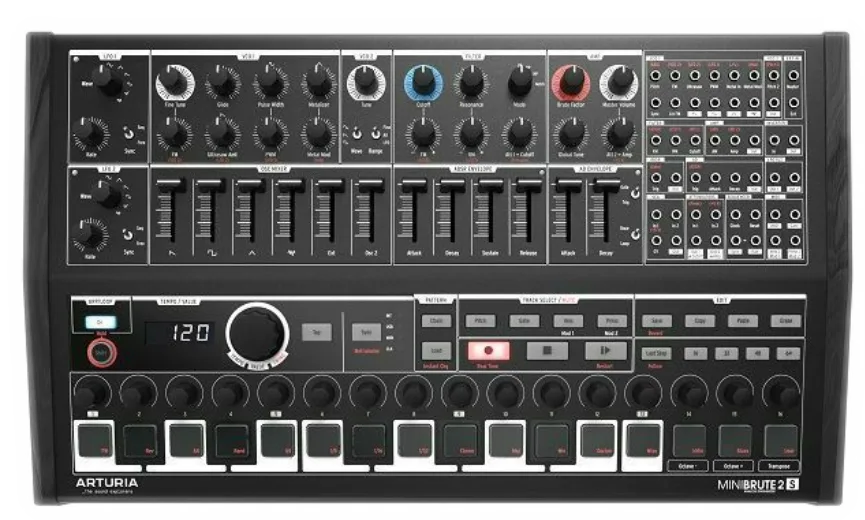The Arturia Minibrute 2S is a large Semi-Modular that is often recommended as a stepping stone into the world of modular, due to its analog synthesis, versatile sequencer and patchbay. I have owned one for around a year now so thought it was a good time to lay down a review.
View the Minibrute 2s in Arturia’s Store on Amazon
Design and Build Quality
There are two versions of the Minibrute 2. One has a traditional keyboard, whereas the ‘S’ variant features a large sequencer instead. I went for the sequencer, as I had heard good things about it and figuring I can always hook up to a MIDI keyboard if I want a more traditional approach.
The original Minibrute 2S features a sleek, black design with faux wooden side panels, giving it a vintage yet modern aesthetic. Instead of the OG, I went for the Noir edition, which has the name implies is more black. It weighs around 3.5 kg, so it has some heft and physically at 19 x 11 inches (484 x 277mm) its even bigger than a TR-8 for example so it chews up a lot of footprint in my setup. The build quality seems solid, and I like the generously sized knobs, sliders, and buttons especially after spending a lot of time recently with the miniscule Roland Airas!
Synth Engine
At its core, the Minibrute 2S boasts a fully analog mono synth engine. The primary oscillator can generate saw, triangle, and square and waves simultaneously, with additional wave-shaping options like Ultrasaw and Metalizer for more unique sounds, as well as a Noise source. Intestingly the 2S also has an external audio input, so you can feed in sounds from external gear. My initial experiments with the external input were disappointing as when I tried adding the other Semi-modular gear I have, such the Behringer Crave and Edge, they were far to quiet even when their output was cranked to the max. A quick bit of google-fu highlighted that the External Audio input is designed to work well with Modular gear, which has a hotter output. So if you do want to use this with other synths, you may have to add an amplifier inbetween.

Patch Me Up
One of the standout features of the Minibrute 2 and 2S is the patchbay, allowing a versatile array of settings to be made by patching cables. There are plenty of suggestions included in the accompanying cookbook that comes with the synth. Once you have come up with the perfect patch then you can save it too, by simply printing up a picture of the synth and laboriously drawing in the position of all of the sliders, dials and wire patches in a selection of colours and write some accompanying notes to describe how the patch works and what parameters to adjust. Easy!

Yeah, right. So this is eiter where you wish you had a digital synth and a modmatrix that could save patches, or alternativley embrace this Semi-Modular world and learn the why and hows as to why patching, LFOs, VCOs, VCAs, Filters work the way they do. I am still learning, but once get a grounding in the Synthesis concepts then patch panels become less daunting and you will soon be on Modular Grid planning your perfect Modular setup.
Sequence and Control
The Minibrute 2S replaces the keyboard of the original MiniBrute with a pad-based step sequencer similar to the BeatStep. Arturia sequencers are fairly intuitive and allows for quick and easy programming of patterns. Additionally, the synth includes MIDI in and out ports, as well as a USB connection for integration with the MIDI Control Centre software. Its the first time I have had a sequencer like this with dials for each step. Starting a pattern going and then tweaking the notes in real time is an absolute delight. You can restrict the scales , so that the adjusted pitches are in tune. Also setting the last step is an easy function for getting some syncopated patterns going.
Rackbrute

As mentioned at the start the Minibrute 2(S) is a gateway drug to modular and to make this even easier, Arturia designed the Rackbrute with a form factor that can be connected and integrated easily with the Minibrute. Asides from the form and asthetics there is not really a compelling reason to pick the rackbrute over other modular cases, although in my case I managed to pick one up at a low price, as I buy a lot of my synthesizer gear second hand.
Integrating with other Synths
Well I am loving the sequencer, I like the sound it makes but don’t love it, I thought this might be because of the Steiner-parker filter, so I hooked it up to a Behringer Crave to use its Moog style filter instead and then found I actually I prefer the built in filter, but this is the nice thing about a Semi-modular synth like the minibrute, you have tons of built in functions, and you can hook up its envelopes, inverters, LFOs and sequencers to other gear and modular.
Summary
The knob perfunciton of analogues is always user-friendly and refreshing after using more digital and menu-diving gear. The Minibrute is a big board, so you will need some space for it, but the controls are a delight compared to the fiddly nature of modular. Most of all I am liking the imediacy and variety that I can create with this synth and for now it is staying front and centre of my setup, for its versatility and ease of use.
View the Minibrute 2s in Arturia’s Store on Amazon
Disclaimer: as an Amazon affiliate I may receive commission from links in this article, at no extra cost to you